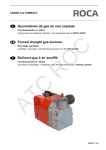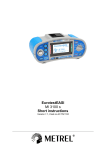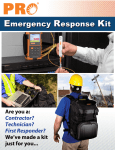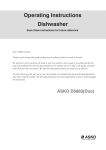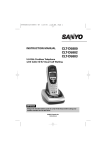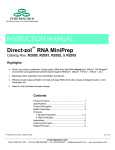Download Riello Two stage operation forced draught natural gas/propane burner Technical data
Transcript
Installation, use and maintenance instructions Forced draught gas burner One stage operation CODE MODEL TYPE 3768000 RDB1 S 960T 2902768 (1) INDEX 1. BURNER DESCRIPTION . . . . . . . . . . . . . . 1 1.1 Burner equipment. . . . . . . . . . . . . . . . . . . . 1 2. 2.1 2.2 2.3 TECHNICAL DATA Technical data . . . . Overall dimensions. Working field . . . . . . . . . . . . . . . . . . . . . . . . . . . . . . . . . . . . . . . . . . . . . . . . . . . . . . . . . . . . . . . . . . . . . . . . . . . . . 2 2 2 3 3. 3.1 3.2 3.3 3.4 3.5 3.6 INSTALLATION . . . . . . . . . Boiler fixing . . . . . . . . . . . . Mounting the burner . . . . . . Gas supply line . . . . . . . . . Gas train. . . . . . . . . . . . . . . Electrical wiring . . . . . . . . . Probe-electrode positioning . . . . . . . . . . . . . . . . . . . . . . . . . . . . . . . . . . . . . . . . . . . . . . . . . . . . . . . . . . . . . . . . . . . . . . . . . . . . . . . . . . . . 4 4 4 5 5 7 8 1. BURNER DESCRIPTION 4. 4.1 4.2 4.3 4.4 4.5 4.6 4.7 4.8 OPERATION . . . . . . . . . . . . . . . . Combustion adjustment . . . . . . . . Combustion head setting . . . . . . . Air dampers adjustment . . . . . . . Combustion check . . . . . . . . . . . . Air pressure test point . . . . . . . . . Air pressure switch . . . . . . . . . . . Burner start-up cycle . . . . . . . . . . Normal operation - flame sensor timing diagnostics . . . . . . . . . . . . . . . . . . . . . . . . . . . . . . . . . . . . . . . . . . . . . . . . . . . . . . . . . . . . . . . . . . 8 8 8 8 9 9 10 10 . . . . . . 10 5. MAINTENANCE . . . . . . . . . . . . . . . . . . . 11 6. 6.1 FAULTS / SOLUTIONS . . . . . . . . . . . . . . 11 Operating fault diagnostics . . . . . . . . . . . . . 13 One stage gas burner. ■ The burner meets protection level of IP 40, EN 60529. ■ CE marking according to Gas Appliance directive 90/396/EEC; PIN 0085BM0490. ■ According to directives: EMC 89/336/EEC, Low Voltage 73/23/EEC, Machines 98/37/EEC and Efficiency 92/42/EEC. ■ Gas train according to EN 676. 9 Fig. 1 2 6 7 5 3 4 1 8 D4193 1 2 3 4 5 – – – – – Pressure switch Gas pressure test point Air damper adjustment Control box Reset button with lock-out lamp 6 7 8 9 – – – – Flange with insulating gasket 4 pole supply socket Air pressure test point Gas train 1.1 BURNER EQUIPMENT Flange with insulating gasket . . . . . . . . . . . . . . 4 pin plug . . . . . . . . . . . . . . . . . . . . . . . . . . . . . Screws and nuts for flange to be fixed to boiler Protection grill for CF applications . . . . . . . . . . . . . . . No. . No. . No. . No. 2768 1 1 1 4 1 90° manual gate valve . . . . . . . . . . . . . . No. 1 Tube 1/2”. . . . . . . . . . . . . . . . . . . . . . . . No. 1 Flange 90° . . . . . . . . . . . . . . . . . . . . . . No. 1 2. TECHNICAL DATA 2.1 TECHNICAL DATA TYPE 960T Thermal power (1) 16 – 47 kW – 13,800 – 40,400 kcal/h Net heat value: 8 – 12 kWh/Nm3 = 7000 – 10,340 kcal/Nm3 Natural gas (Family 2) Pressure: min. 20 mbar – ~ 50Hz max. 65 mbar 230V ± 10% Electrical supply Single phase, Motor Run current 0,58A Capacitor 2 µF Ignition transformer Primary 220-240V – 50-60Hz Absorbed electrical power 0,09 kW - 2750 rpm - 289 rad/s – Secondary 15 kV - 25 mA (1) Reference conditions: Temp. 20°C - Barometric pressure 1013 mbar – Altitude 0 m above sea level. For gas family 3 (LPG) ask for separate kit. COUNTRY AT - DK - IT - GR - SE GB - IE - ES - PT DE FR NL LU II2H3B/P II2H3P II2ELL3B/P II2Er3P II2L3B/P II2E3B/P GAS CATEGORY GAS PRESSURE G20 H 20 20 – – – 20 G25 L – – 20 – 25 – G20 E – – 20 20 / 25 – – 2.2 OVERALL DIMENSIONS Burner 195 Flange 141 115 207 180 91 11 72 72 ° 45 168 222 230 ø 89 45° ø 75 130 150 D4194 20 2768 2 D4212 Pressure in the combustion chamber - mbar 2.3 WORKING FIELD (as EN 676) kW D4206 kcal/h Thermal power TEST BOILER The working field has been defined according to EN 676 standard. COMMERCIAL BOILERS The burner-boiler matching is assured if the boiler is according to EN 303 and the combustion chamber dimensions are similar to those shown in the diagram EN 676.For applications where the boiler is not according to EN 303, or where the combustion chamber dimensions differ from those shown in EN 676, please consult the manufacturers. CORRELATION BETWEEN GAS PRESSURE AND BURNER OUTPUT Gas pressure in the combustion head – mbar To obtain the maximum output, a gas head pressure of 5 mbar is measured (M3, see chapter 3.3, page 5) with the combustion chamber at 0 mbar using gas G20 with a net heat value of 10 kWh/Nm3 (8,570 kcal/Nm3). kW D4207 kcal/h Thermal power 2768 3 3. INSTALLATION THE BURNER MUST BE INSTALLED IN CONFORMITY WITH LEGISLATION AND LOCAL STANDARDS. 3.1 BOILER FIXING ➤ Put on the flange (1) the screw and two nuts, (see fig. 2). ➤ Fix the flange (1) to the boiler door (4) using screws (2) and (if necessary) the nuts (3) interposing the insulating gasket (5), (see fig. 3). Fig. 2 Fig. 3 1 5 3 1 E9095 E9094 4 2 3.2 MOUNTING THE BURNER In case of CF applications, the burner shall not operate without protection grill (A) of the suction inlet. In case of BF applications the combustion air supply is through a flexible tube connected at the snorkel (B). Note. This item is supplied in the burner carton. A B D5884 D5883 2768 4 3.3 GAS SUPPLY LINE 1 2 3 4 5 6 M1 7 8 9 10 11 12 M2 13 M3 14 D4208 3.4 GAS TRAIN (as EN 676) LEGEND Type MBDLE 055 D01 1 - Gas supply pipe Use Natural gas and LPG 2 - Manual cock (Supplied by the installer) COMPONENTS The multibloc is composed by: 1 - Filter 1 - Gas pressure switch 1 - Pressure stabilizer 2 - Solenoid valves: - safety valve with fast opening. - adjusting valve with slow opening. 4 - Gas pressure gauge (Supplied by the installer) 5 - 90° manual gate valve (supplied standard) 6 - Filter 7 - Gas pressure switch 8 - Safety valve 5 11 M2 M3 1 1/2” Fig. 4 3 - Antivibration joint (Supplied by the installer) 9 - Adjusting valve 10 - Pressure stabilizer 11 - Brake adjustment 12 - Stabiliser adjustment 13 - Valve adjustment 12 14 - Valve - burner adaptor 15 - Flange 90° 13 16 - Flange fixing screws 17 - Sealing rings 14 M1 - Gas-supply pressure test point 16 M2 - Test point for measuring pressure after stabilising M3 - Pressure coupling test point D4195 15 16 17 17 7 M1 2768 5 GAS TRAIN PRESSURE LOSS VALVE ADJUSTMENTS The slow opening of the valve providing reduced ignition gas is adjusted by turning the screw (11, fig. 4 page 5) anti-clockwise to increase the start gas quantity & clockwise to decrease it. It is possible to set the valve to give an ignition gas rate of 80% of the maximum, however to ensure smooth ignition, we would recommend that this value is kept to a minimum value but that allows reliable operation. The introduction of the main gas output is achieved through the valve continuing to open slowly once ignition has been achieved. The main gas throughput is set by adjusting the screw (13, fig. 4 page 5) anticlockwise to increase rate & clockwise to decrease. LOW GAS PRESSURE SWITCH ADJUSTMENT Adjust the gas pressure switch (7, fig. 4 page 5) after carrying out all the other adjustments of the burner with the gas pressure switch adjusted at the beginning of the scale. Let the burner work at the required output. Slowly start to close the gas isolation valve on the gas supply manifold reducing the pressure by 5 - 6 mbar from that recorded as the normal working gas pressure measured on your pressure gauge. Rotate the dial on the pressure switch until the dial reads just below the reduced value now showing on your pressure gauge, the burner should shut down. Open op the isolation valve & check that the burner starts & runs correctly. INITIAL ADJUSTMENT OF THE GAS VALVE D4061 ADJUSTMENT OF THE START GAS FLOW (11, fig. 4 page 5) Rotate the screw (11) clockwise until a resistance is felt. Rotate the screw anticlockwise for 7 turns. This is an initial setting and may require adjusting for different outputs. The gas train pressure loss ∆p is provided from the ° are diagram; the scales of the volumetric output V valid respectively for: a = air, n = natural gas (G20), p = propane (G30), c = city gas (G140), only for applications not covered by the Gas Appliances Directive (90/396/EEC). The value indicated in the diagram will differ according to the adjustment of the pressure stabilizer. ADJUSTMENT OF THE MAIN FLOW RESTRICTOR (13, fig. 4 page 5) Rotate the screw (13) clockwise until a resistance is felt. Rotate the screw anticlockwise for three turns. This is an initial setting for the burner to fire and will require adjusting for different outputs. The minimum necessary pressure in the network can be obtained by adding the pressure of the diagram to the burner pressure losses and the back pressure of the combustion chamber (see the technical instruction of the heat generator). PRESSURE GOVERNOR (12, fig. 4 page 5) Rotate the screw (12) anticlockwise until you hear the click at the end of a full rotaton at this point. Rotate the screw clockwise by 12 turns this will set the governor at a mid position from where adjustments to the through put can be made. FILTER MAINTENANCE If necessary the filter can be replaced; for this operation you must call the service agent. GAS PRESSURE (M3, fig. 4 page 5) The gas head pressure is measured at the pressure test point (M3). PRESSURE STABILIZER ADJUSTMENT By rotating the pressure regulator adjustment screw clockwise, the gas head pressure & thus output increases. Anti-clockwise reduces the pressure & output. AIR DAMPER ADJUSTMENT The air is adjusted by turning the screw (3, fig. 6, page 9). 2768 6 3.5 ELECTRICAL WIRING WARNING NOTES: – Wires of min. 1 mm2 section. (Unless requested otherwise by local standards and legislation). – The electrical wiring carried out by the installer must be in compliance with the rules in force in the country. DO NOT EXCHANGE NEUTRAL WITH PHASE ~ 50Hz - 230V TESTING: Check that the burner shuts down when the boiler thermostat contacts open. Also check that the burner locks out when the connector (CN1) fitted in the red probe lead is disconnected. LEGEND CARRIED OUT IN THE FACTORY SO T6A TA TB TL TS V10 V11 X4 XP4 Blue White Black CONTROL BOX Red D4210 C – CN1 – F1 – MV – PA – PG – S3 – Brown 2768 7 – – – – – – – – – – Capacitor Connector Suppressor Motor Air pressure switch Min. gas pressure switch Remote lock-out signal (230V - 0.5A max.) Ionization probe Fuse Ignition transformer Burner earth Limit thermostat Safety thermostat Safety valve Adjusting valve 4 pin plug 4 pole socket 3.6 PROBE-ELECTRODE POSITIONING Make sure that the ceramic is behind the diffuser disc and level with it. Ionization probe Diffuser Ignition electrode Probe 1.7 Electrode D4202 WARNING 2.5 – 3.5 mm 4. OPERATION 4.1 COMBUSTION ADJUSTMENT In conformity with Efficiency Directive 92/42/EEC the application of the burner on the boiler, adjustment and testing must be carried out observing the instruction manual of the boiler, including verification of the CO and CO2 concentration in the flue gases, their temperatures and the average temperature of the water in the boiler. To suit the required appliance output, choose the proper setting of the combustion head, and the main air damper opening in accordance with the following table. Burner thermal power Main air Combustion head setting damper setting Position Position 16 – 26 kW 1 1 26 – 47 kW 2 2 2 Fig. 5 C 4.2 COMBUSTION HEAD SETTING (see fig. 5) The combustion head setting must be carried out by the installer, and set as indicated in the table above. To set the position of the head, proceed as follows: remove screw (2) and release screws (1) position the combustion head / gas valve assembly (C) to either set point 1 or 2. Tighten screws (1) and refit screw (2). s. Po 1 s. Po 2 E9175 1 The combustion head leaves the factory preset to position (2). 4.3 AIR DAMPERS SETTING (see fig. 6, page 9) The air setting is performed by mean of two independent dampers. ■ MAIN AIR DAMPER (A) The main air damper can be set in either of two positions. To set the positions of the damper, proceed as follows: release the secondary air damper (B) loosing the screws (1). E9174 Loosen the screw (2) and rotate the main air damper (A) to the required position 1or 2. Retighten the screw (2) and put back the secondary air damper (B). The main air damper is factory preset to position 2. 2768 8 ■ SECONDARY AIR DAMPER (B) The purpose of this damper is to perform a fine-tuning of the inlet air. Tuning of this device is possible acting of the screw (3). Main air damper assembly (A) Secondary air damper (B) Fig. 6 B 2 3 B D4202 1 A D4202 4.4 COMBUSTION CHECK It is advisable to set the burner according to the type of gas used and following the indications of the table: AIR EXCESS: max. output λ ≤ 1.2 – min. output λ ≤ 1.3 EN 676 GAS Theoretical max. CO2 0 % O2 G 20 G 25 G 30 G 31 11.7 11.5 14.0 13.7 Setting CO2 % λ = 1.2 9.7 9.5 11.6 11.4 IONIZATION CURRENT The minimum current necessary for the control box operation is 5 µA. The burner normally supplies a higher current value, so that no check is needed. To measure the ionization current, open the connector CN1 (see electrical scheme page 7) & insert your microammeter. See fig. 7 λ = 1.3 9.0 8.8 10.7 10.5 CO mg/kWh NOx mg/kWh ≤ 100 ≤ 100 ≤ 100 ≤ 100 ≤ 170 ≤ 170 ≤ 230 ≤ 230 Fig. 7 Connector Terminal block of control-box 1 Probe D5006 Fig. 8 Air pressure test point 4.5 AIR PRESSURE TEST POINT 30° Attention The air pressure switch sensing point must be correctly located within the fan scoop. If for any reason this has been moved, set it according to the diagram in fig 6. D4244 2768 9 4.6 AIR PRESSURE SWITCH Adjust the air pressure switch after having performed all other burner adjustments starting with the air pressure switch set to the start of the scale. With the burner operating at the required power, slowly turn knob clockwise until burner locks out. Then turn the knob anti-clockwise by about 20% of the set point and subsequently check to see if burner has started correctly. If the burner locks out again, turn the knob anti-clockwise a little bit more. Attention As a rule, the air pressure switch must prevent the air pressure from lowering below 80% of the adjustment value as well as preventing CO from forming in the flue gases. Typical normal operating values would be below 100 ppm. However to check the operation of the air pressure switch, the air intake can be slowly blocked off until the burner locks out. The CO concentration in the flue gases must not exceed (1%) 10,000 ppm. To check this, insert a combustion analyser into the chimney, slowly close the fan suction inlet (for example with cardboard) and check that the burner locks out, before the CO in the fumes exceeds 1%. 4.7 BURNER START-UP CYCLE Normal A Lock-out, due to light failure Thermostat Motor Ignition transformer Valve Flame signal Lock-out signal Remote reset signal Air pressure switch 2,5s 2s 37s 400 ms 2,5s 2s 400 ms 3s 3s D4245 36s A Lock-out is indicated by a lamp on the control box (5, fig. 1, page 1). When the flame-failure occurs during working, shut down takes place within one second. 4.8 NORMAL OPERATION - FLAME SENSOR TIMING DIAGNOSTICS The control box has a further function by means of which it is possible to check the correct running of the burner (signal: GREEN LED permanently lit up). In order to use this function, it is necessary to wait at least ten seconds from the firing up of the burner and press the button of the control box for a minimum of three seconds. Once the button has been released, the GREEN LED will start to flash, as illustrated in the diagram below. GREEN LED on wait at least 10s Press button for > 3s = Interval 3s Signal = = = = Signal = = = = = The pulses of the LED constitute a signal spaced by approximately 3 seconds. The number of pulses will identify the SENSOR TIMING of the probe from opening of the gas valve, according to the table below. SIGNAL 1 = 2 == 7 ======= FLAME SENSOR TIMING ≤ 0.4s ≤ 0.8s ≤ 2.8s Each time the burner is operated, this information is up-dated. Once the reading has been taken, by pressing the button on the control box briefly, the burner repeats the start cycle. WARNING If a timing of > 2 seconds occurs, delayed start-up is present. Check the setting of the hydraulic brake in the gas valve and the setting of the air gate valve and the combustion head. 2768 10 5. MAINTENANCE The burner requires periodic maintenance carried out by a qualified and authorised technician in conformity with legislation and local standards. Maintenance is essential for the reliability of the burner, avoiding the excessive consumption of fuel and consequent pollution. Before carrying out any cleaning or control always first switch off the electrical supply to the burner acting on the main switch of the system. THE BASIC CHECKS ARE: Leave the burner working without interruptions for 10 min. set correctly all the components stated in this manual. Then carry out a combustion check verifying: ● Content of CO2 (%) ● Content of CO (ppm) ● Flue gas temperatures. 6. FAULTS / SOLUTIONS Below are some examples of causes & possible solutions that could result in the burner failing to operate or that result in it working incorrectly. A fault usually makes the lock-out lamp light which is situated inside the reset button of the control box (5, fig. 1, page 1). When lock out lamp lights the burner will attempt to light only after pushing the reset button. After this if the burner functions correctly, the lock-out can be attributed to a temporary fault. If however the lock out continues the cause must be determined and the solution found. BURNER STARTING DIFFICULTIES FAULTS POSSIBLE CAUSES SOLUTION Check presence of voltage in the L1 - N clamps of the 4 pin plug. Lack of electrical supply. Check the condition of the fuses. Check that the boiler high limit thermostat has not operated. Check that the manual gas isolation valve is open. The burner will not start when the adjustment thermostat closes. The burner runs normally in the prepurge and ignition cycle and locks out after about 3 seconds. Lack of gas. Check that the burner gas valves are wired correctly & that they are opening & passing gas once energized (Verify this by using your gas pressure gauge). The gas pressure switch does not close its contact. Adjust the gas pressure switch to its correct setting. The connections in the control box are wrongly inserted. Check and connect all the plugs. The air pressure switch contact is in the run position when the burner is at rest. Replace the air pressure switch. Phase and neutral connection is inverted. Connect them correctly. Check that the burner earth connections are well made. Connect them correctly. The ionization probe is earthed or not in contact with the flame, or its wiring to the control box is broken, or there is a fault on its insulation to the earth. 2768 11 Check the right position and if necessary set it according to the instructions of this manual. Reset the electrical connection. Replace the faulty connection. FAULTS The burner starts with an ignition delay. The burner locks out after the prepurge phase due to flame-failure. The burner locks out during the prepurge phase. The burner continues to repeat the starting cycle without going on lockout. POSSIBLE CAUSES SOLUTION The ignition electrodes is wrongly positioned. Adjust it according to the instructions of this manual. The air setting is to high for the burner output. Set the air output according to the instructions of this manual. The start gas is insufficient. Increase the start gas volume. The solenoid valves is passing too little gas. Check the supply pressure from the network & adjust the gas multibloc valve according to the instructions. The solenoid valves are defective. Replace the valve bloc. Check the right insertion of the connectors. The ignition arc is irregular or has failed. Check the right position of the electrode according to the instructions of this manual. The gas supply pipe and/or the valve bloc has not been purged of air. Purge the air in accordance with the gas safety in use regulations. The air pressure switch does not change over to the operational position. The pressure switch is faulty, change it. The flame exists. Faulty valves: replace them. The pressure test point (pos. 8, fig. 1, page 1) is badly positioned. Place it in the right position according to the instructions of this manual on page 1, chapter 1. The pressure in the gas supply is close to the setting of the pressure switch. When the valve opens the pressure in the supply drops & the gas pressure switch stops the burner working. Once the burner valve closes the pressure in the supply increase & makes the pressure switch again, and the cycle continues. Set the pressure switch according to the manual. 2768 12 The developed air pressure is to low, check the burner head setting. 6.1 OPERATING FAULT DIAGNOSTICS The control box has a self-diagnostic system, which easily allows identifying the operating faults (RED LED signal). To use this function, wait at least ten seconds from the safety lock out, and then press the reset button for a minimum of 3 seconds. After releasing the button, the RED LED starts flashing as shown in the diagram below. RED LED on wait at least 10s 3s Press reset for > 3s Blink code = = = = interval = Blink code = = = = = The LED gives of a blink code every 3 seconds. The blink codes give the information about the possible faults, as follows: BLINK CODE POSSIBLE CAUSE 2 blinks == The flame does not stabilize at the end of the safety time: – faulty or soiled ionization probe; – faulty or soiled fuel valves; – neutral/phase exchange; – poor burner regulation. 3 blinks === Minimum air pressure switch does not close: – air pressure switch faulty; – air pressure switch incorrectly regulated; – fan motor does not run. 4 blinks ==== Minimum air pressure switch does not open or extraneous light on burner start-up: – air pressure switch faulty; – air pressure switch incorrectly adjusted. 5 blinks ===== Extraneous light during pre-purging, or control box faulty. 7 blinks ======= Loss of flame during operation: – poor burner regulation; – faulty or soiled fuel valves; – short circuit between ionization probe and earth. 18 blinks ========= ========= Minimum air pressure switch opens during pre-purging or operation: – air pressure switch incorrectly regulated; – the flame disappeared 4 times during working (3 attempts allowed). 19 blinks ========== ========= Faulty on output contacts of control box: – wiring error; – power could be present in the outlet loads. 20 blinks ========== ========== Control box faulty. 2768 13

















